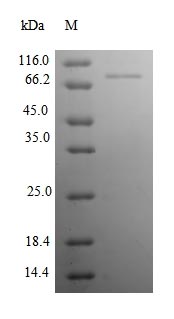Recombinant rat neural cell adhesion molecule 1 (Ncam1) production starts with isolating the target gene corresponding to the rat Ncam1 (20-721aa). This gene is co-inserted into an expression vector with an N-terminal 10xHis-tag and C-terminal Myc-tag gene and then introduced into E. coli cells via transformation. The positive E. coli are cultured and induced to express the recombinant Ncam1 protein, which is subsequently harvested from the cell lysate. Purification of the recombinant Ncam1 protein is commonly achieved using affinity chromatography. Its purity is over 90% as determined by SDS-PAGE.
Rat Ncam1 is expressed in different tissues and cell types in rats, including the hippocampus, cardiomyocytes, and pulmonary arterial smooth muscle cells [1][2][3]. In the hippocampus, Ncam1 is associated with adult neurogenesis and is expressed by immature neurons, contributing to cell communication and stem cell functions [4][5]. Ncam1 expression has been linked to cognitive function, with studies indicating that manipulating its expression levels can impact cognitive outcomes in rats [6][7].
Furthermore, Ncam1 has been implicated in synaptic plasticity and neuronal differentiation. Research has demonstrated that Ncam1 isoforms are involved in proteome dynamics during neuronal differentiation, affecting processes such as cell differentiation and growth cone formation. Evidence has found that Ncam1 deficiency disrupts long-term synaptic plasticity, thus impairing the ability of learning and memory.
Ncam1 is associated with postoperative cognitive dysfunction and pulmonary hypertension. Studies have indicated that modulating Ncam1 expression levels can influence cognitive function recovery in rats with postoperative cognitive dysfunction [7].
References:
[1] T. Seki, Hippocampal adult neurogenesis occurs in a microenvironment provided by psa‐ncam‐expressing immature neurons, Journal of Neuroscience Research, vol. 69, no. 6, p. 772-783, 2002. https://doi.org/10.1002/jnr.10366
[2] L. Kahn, G. Alonso, E. Normand, & O. Manzoni, Repeated morphine treatment alters polysialylated neural cell adhesion molecule, glutamate decarboxylase‐67 expression and cell proliferation in the adult rat hippocampus, European Journal of Neuroscience, vol. 21, no. 2, p. 493-500, 2005. https://doi.org/10.1111/j.1460-9568.2005.03883.x
[3] Q. Kong, M. Xia, R. Sun, J. Gao, R. Liang, L. Liet al., Effects of pharmacological treatments on hippocampal ncam1 and erk2 expression in epileptic rats with cognitive dysfunction, Oncology Letters, vol. 12, no. 3, p. 1783-1791, 2016. https://doi.org/10.3892/ol.2016.4882
[4] C. Frese, M. Mikhaylova, R. Stucchi, V. Gautier, Q. Liu, S. Mohammedet al., Quantitative map of proteome dynamics during neuronal differentiation, Cell Reports, vol. 18, no. 6, p. 1527-1542, 2017. https://doi.org/10.1016/j.celrep.2017.01.025
[5] H. Cremer, G. Chazal, A. Carleton, C. Goridis, J. Vincent, & P. Lledo, Long-term but not short-term plasticity at mossy fiber synapses is impaired in neural cell adhesion molecule-deficient mice, Proceedings of the National Academy of Sciences, vol. 95, no. 22, p. 13242-13247, 1998. https://doi.org/10.1073/pnas.95.22.13242
[6] X. Yu, S. Liu, J. Li, X. Fan, Y. Chen, X. Biet al., Microrna-572 improves early post-operative cognitive dysfunction by down-regulating neural cell adhesion molecule 1, Plos One, vol. 10, no. 2, p. e0118511, 2015. https://doi.org/10.1371/journal.pone.0118511
[7] A. Luo, Proteomic and phosphoproteomic analysis of right ventricular hypertrophy in the pulmonary hypertension rat model, Journal of Proteome Research, vol. 23, no. 1, p. 264-276, 2023. https://doi.org/10.1021/acs.jproteome.3c00546






